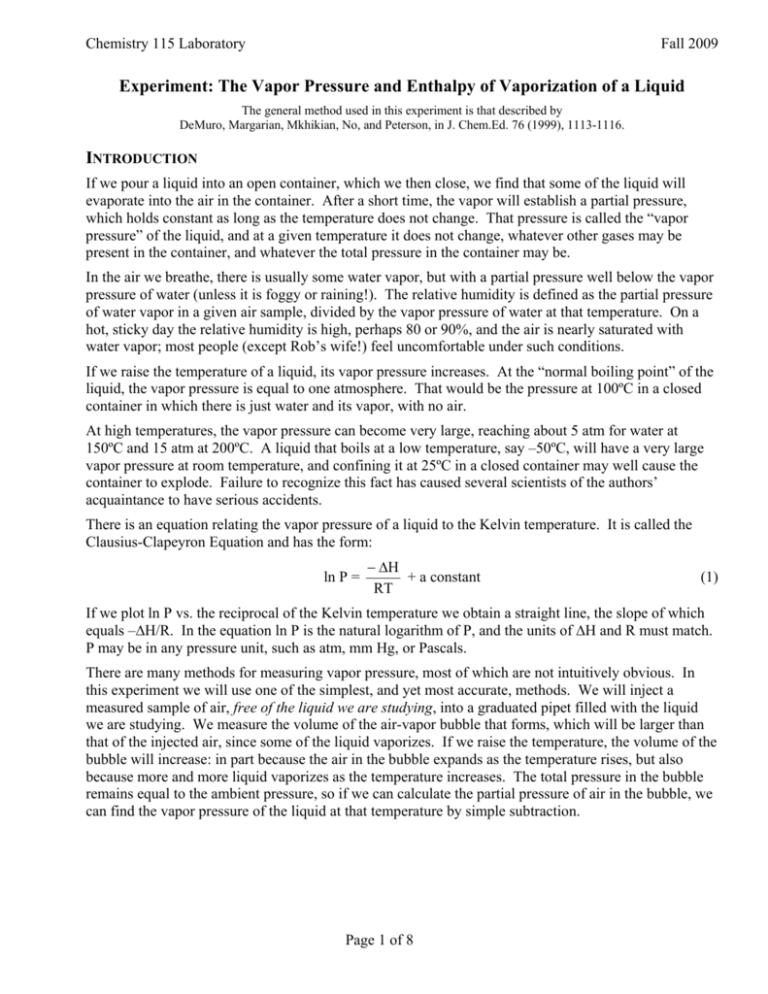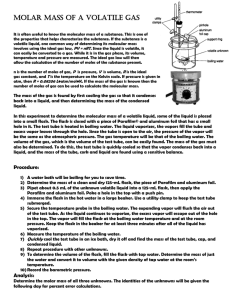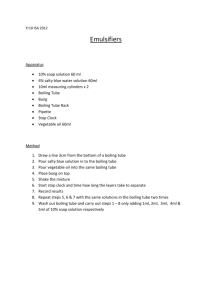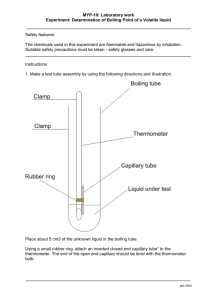Experiment: The Vapor Pressure and Enthalpy of Vaporization of a
advertisement

Chemistry 115 Laboratory Fall 2009 Experiment: The Vapor Pressure and Enthalpy of Vaporization of a Liquid The general method used in this experiment is that described by DeMuro, Margarian, Mkhikian, No, and Peterson, in J. Chem.Ed. 76 (1999), 1113-1116. INTRODUCTION If we pour a liquid into an open container, which we then close, we find that some of the liquid will evaporate into the air in the container. After a short time, the vapor will establish a partial pressure, which holds constant as long as the temperature does not change. That pressure is called the “vapor pressure” of the liquid, and at a given temperature it does not change, whatever other gases may be present in the container, and whatever the total pressure in the container may be. In the air we breathe, there is usually some water vapor, but with a partial pressure well below the vapor pressure of water (unless it is foggy or raining!). The relative humidity is defined as the partial pressure of water vapor in a given air sample, divided by the vapor pressure of water at that temperature. On a hot, sticky day the relative humidity is high, perhaps 80 or 90%, and the air is nearly saturated with water vapor; most people (except Rob’s wife!) feel uncomfortable under such conditions. If we raise the temperature of a liquid, its vapor pressure increases. At the “normal boiling point” of the liquid, the vapor pressure is equal to one atmosphere. That would be the pressure at 100ºC in a closed container in which there is just water and its vapor, with no air. At high temperatures, the vapor pressure can become very large, reaching about 5 atm for water at 150ºC and 15 atm at 200ºC. A liquid that boils at a low temperature, say –50ºC, will have a very large vapor pressure at room temperature, and confining it at 25ºC in a closed container may well cause the container to explode. Failure to recognize this fact has caused several scientists of the authors’ acquaintance to have serious accidents. There is an equation relating the vapor pressure of a liquid to the Kelvin temperature. It is called the Clausius-Clapeyron Equation and has the form: ln P = H + a constant RT (1) If we plot ln P vs. the reciprocal of the Kelvin temperature we obtain a straight line, the slope of which equals –∆H/R. In the equation ln P is the natural logarithm of P, and the units of ∆H and R must match. P may be in any pressure unit, such as atm, mm Hg, or Pascals. There are many methods for measuring vapor pressure, most of which are not intuitively obvious. In this experiment we will use one of the simplest, and yet most accurate, methods. We will inject a measured sample of air, free of the liquid we are studying, into a graduated pipet filled with the liquid we are studying. We measure the volume of the air-vapor bubble that forms, which will be larger than that of the injected air, since some of the liquid vaporizes. If we raise the temperature, the volume of the bubble will increase: in part because the air in the bubble expands as the temperature rises, but also because more and more liquid vaporizes as the temperature increases. The total pressure in the bubble remains equal to the ambient pressure, so if we can calculate the partial pressure of air in the bubble, we can find the vapor pressure of the liquid at that temperature by simple subtraction. Page 1 of 8 Chemistry 115 Laboratory Fall 2009 SAFETY ISSUES AND LOGISTICS In order to eliminate any danger of explosion in this experiment, no tightly sealed container of any type should be heated: either by placing it in a hot water bath, or by holding it in your hand! DO NOT SEAL THE STOPPER ON THE TEST TUBE WITH THE THERMOMETER PROBE! Wear your safety goggles while performing this experiment. Avoid inhaling the vapors generated by the unknowns at high temperatures. They have all been selected for their safety, but some can cause nausea or have narcotic effects. EXPERIMENTAL PROCEDURE Determining the Vapor Pressures 1. Obtain a “device” (a half-sealed ½ m graduated pipet segment: see picture below), a large-hole stopper, and a Pasteur pipet from the front of the room. (Assemble the Pasteur pipet by attaching a yellowish rubber bulb to it, also available up front.) From the center console of your lab bench, select one of the unknown liquid samples from the center console of your lab bench; its density will be indicated on the bottle. Finally, obtain a small Erlenmeyer flask from your drawer. “Dead Volume” “Zero” mark on “device” Bubble Unknown liquid in “device” Air injection syringe A picture of a “device,” with a syringe needle in it. The “device” itself is the glass tube on the left side. 2. Record the number and density of your unknown liquid. Don’t forget to observe your unknown, which in this case includes wafting its fumes toward your nose with your hand to assess its smell! 3. Place the device, open end up, in the Erlenmeyer flask (so you don’t have to hold it with your hand while it is being filled with the unknown). 4. Using your Pasteur pipet, carefully fill the device completely with your unknown liquid. 5. Dry off the outside of the device with a paper towel and determine its mass on an analytical balance. (You know the difference between an analytical and a top-loading balance by now!) Be careful around the top of the device – dry only up to the top edge, and don’t let the paper towel suck liquid out of the device! You want the liquid level in the device flush with the top surface of the device. The surface tension of the liquid will keep it from escaping the device, even if it is set on its side, so weigh only the device, setting it directly on the balance – don’t weigh your Erlenmeyer flask. Don’t heat up the device by holding the bubble part of it with your hand! 6. Request your instructor’s help. Using a syringe, your instructor will inject 0.200 mL of ambient air at the closed end of the inverted device, forming an air bubble. (Surface tension will keep the liquid in the device, even when it is inverted!) After the syringe is removed, the device will not be completely full at the open end, so add more unknown with your Pasteur pipet, until it is full. 7. Carefully dry and reweigh your device on the same analytical balance you used before. Be sure that the liquid level in the device is again even with its top edge, as close as possible to the way it was when you weighed the device without the bubble in it in Step 5. The accuracy of your results hinges strongly on the quality of your two mass measurements – make them very carefully! 8. Select one of the larger test tubes from your drawer (18150 mm). (One with a rim works best!) 9. Pour enough of your unknown liquid into the test tube to fill it about ¾ full. Page 2 of 8 Chemistry 115 Laboratory Fall 2009 10. Make sure that the unknown liquid fills the device’s open end completely. 11. Gently drop your device, open end down, into the liquid-filled test tube. 12. Using your Pasteur pipet, add more of your unknown liquid to the test tube until the liquid level is a few millimeters above the top of your device. Close the bottle containing your unknown! 13. Insert the temperature probe of a digital thermometer into the unknown liquid, through a holed stopper that does not cause the tube to be completely sealed. (These are available at the front of the room, next to the “devices”.) 14. Record the unknown liquid’s temperature. Do not hold the test tube while taking this measurement or the subsequent ones, or you’ll warm it up! 15. Read the ambient air temperature and the atmospheric (laboratory) pressure from the weather monitor at the front of the room. Please make careful note of the units! Our weather monitors read pressures in millibar (or, equivalently, hectoPascals)! 16. Swirl your test tube until the bubble moves all the way to the very top of the device. Read and record the reading on the device as accurately as possible. (This is a crucial step, so take your time, and read to the nearest 0.002 mL. Remember to account for the meniscus! Note that the numbers on the pipet are in 0.1 mL increments, so each gradation indicates 0.01 mL). 17. Grip your test tube (with the device and unknown liquid in it) with the test tube clamp from your lab drawer. Position the clamp near the top of the test tube, just below the rim and stopper. You are encouraged to use tape to secure the test tube to the clamp, so you don’t mistakenly drop it! 18. Submerge your test tube to the level of your unknown liquid in the large, 35C water bath. [Do not dip your test tube deep enough into the water bath that any water gets into your unknown liquid – doing so will mess up your results!] Swirl your test tube around in the bath gently, while monitoring the temperature of your liquid, as indicated by your digital thermometer. (It helps to swish the thermometer probe in gentle circles through the hole in the stopper.) When the temperature stops rising, and remains constant for at least 30 seconds, record it. Then record the volume reading on your device, as accurately as you can. (If you remove your test tube from the water bath to take this last measurement, don’t take too long! It is important that the device be at the temperature you read when the volume reading on the device is determined.) 19. Repeat the previous step for baths of progressively higher temperature, until you run out of baths or the bubble fills the device completely and starts to escape. You should be able to collect data for at least five temperatures above room temperature, no matter which unknown you have. 20. The data you have collected up to this point will allow you to determine the boiling point of your unknown liquid in an indirect way, as outlined in the Calculations section. Next you will measure the boiling point of your liquid directly. This will allow you to check your calculations, and get some idea of the validity of your results. Direct Measurement of the Boiling Point To measure the boiling point of your unknown liquid at atmospheric pressure: 1. Bring your device-containing test tube and a 250 mL Erlenmeyer flask to one of the boiling point stations set up in the fume hoods around the room. (Use the flask as a “stand” for the test tube.) 2. Check to make sure that there are a few small black grains inside the big test tube in the boiling station. These are “boiling stones,” actually chips of silicon carbide, which help ensure that your unknown liquid will boil smoothly and gently rather than “bumping” and splashing hot liquid everywhere. If there are no boiling stones in your large test tube, ask for some. 3. Pour roughly half of the unknown liquid in your small test tube into the large one with the boiling stones. (Do not transfer the device.) Put the small test tube back into its Erlenmeyer flask holder. Page 3 of 8 Chemistry 115 Laboratory Fall 2009 4. The boiling point determination apparatus should be arranged as shown in the pictures at right. The thermometer’s immersion line (a thicker black line below the bottom temperature marking, about three inches above the bulb) should be positioned at the top lip of the large test tube. The stopper holding the thermometer should be well above the test tube, and the split stopper definitely must not seal the test tube! The large test tube should be positioned so that the unknown liquid level is a few centimeters below the water level, and the test tube is positioned near the edge of the water bath. 5. Turn the HEAT setting on the hotplate to 10, making sure that the magnetic stir bar is turning smoothly with the STIR control set to about 6. 6. Heat the water in the water bath until the liquid in the test tube begins to boil, as evidenced by bubbles roiling off the boiling stones continuously. Shortly after boiling starts, the thermometer reading should shoot up, and then stabilize at the normal boiling point of the unknown liquid. Record it carefully. 7. Turn off the HEAT setting on the hotplate in the hood, but allow STIRRING to continue. [This is important! The stirring keeps the water from “bumping!”] 8. Move the thermometer's clamp up to the top of the stand, and then elevate the large test tube’s clamp such that the large test tube is held in place well above, or off to the side of, the water bath. 9. Carefully pour the rest of your unknown liquid, and the device, into the large test tube. Leave them there. We’ll take care of the rest of the cleanup process. Return the small test tube and your flask to your drawer, after rinsing the test tube with warm tap water and then DI water. 10. The glass portion of your Pasteur pipet goes in the broken glass box. Please return the yellow rubber bulb to the front of the room for re-use! Page 4 of 8 Chemistry 115 Laboratory Fall 2009 DATA ANALYSIS AND CALCULATIONS The challenging part of this experiment lies in correctly analyzing your data. The data you have obtained will allow you to calculate the vapor pressure of your unknown liquid at each temperature you used. Plotting this data in the correct manner, as indicated by Equation 1, will allow you to extract the enthalpy of vaporization, Hvap, of your liquid from the slope of a line. The formula of the line will also allow you to calculate the normal boiling point of the liquid. We will provide you a general guide to working up the data, but you have to work out the details for yourself. Be sure to clearly document your process with a sample calculation, verbally annotated with a description of your thought process. We urge you to use Excel for the data workup and plotting, but anything that produces a large, properly labeled plot is fine. Using a calculator to make your plot is not acceptable. Make your plot large enough that you can see how closely your points fall on the line! Determining the Enthalpy of Vaporization (Hvap) of the Liquid 1. Using the mass measurements you took at the start of the experiment, you can determine the mass of liquid driven out by the addition of the air bubble. 2. The initial volume of the bubble can be calculated from this mass of liquid displaced and the (given) density of the unknown liquid. It should be more than 0.200 mL! 3. This volume is larger than that of the air injected, since some of the liquid vaporizes into the bubble. There should be 0.200 m of air in that bubble – the rest is vapor from your unknown. 4. The “devices” are home-brewed, and contain a “dead volume” above the zero mark: so their markings are only calibrated for correct measurement of differences. Whatever the reading on your device at the start of the experiment, that reading corresponds to the actual bubble volume you calculated in the step above. You will need to correct all the rest of your device readings to actual volumes by assuming that if the reading on the device increases by some amount, say 0.15 mL, then the actual volume of the bubble also increases by that amount. In short, you’ll want to know what each “Reading on Device” corresponds to in terms of an “Actual Volume of Bubble.” 5. As this experiment proceeds, everything is kept open to the atmosphere. As a result, the total pressure in the bubble is always equal to the ambient (laboratory) pressure. But there are two contributions to this total pressure: the partial pressure of the air, and the partial pressure of the vapor. We can figure out the partial pressure of the air, because we know we started out by injecting 0.200 mL of air, at room temperature, into the device. We can figure out how many moles of air we injected by simple application of the ideal gas law. 6. The ideal gas law can be written for gas mixtures as follows: n RT PxV = nxRT Px = x (2) V We can figure out Pair, because we know nair, the number of moles of air we injected. Thus, at each temperature, we can figure out the partial pressure of the air from the temperature and volume of the bubble. Because the only other contribution to the total pressure is the vapor, and we know the total pressure is equal to the ambient, atmospheric pressure in the lab, we can obtain the vapor pressure of the liquid at each temperature by subtracting the partial pressure of the air from the ambient pressure, which is the total pressure of the gas bubble. 7. Do this calculation by hand, once, to see how it works. (This can serve as your vapor pressure sample calculation, too. Just be sure to add an example of how you calculated the bubble volume at other temperatures!) Then make up an Excel spreadsheet that does the rest of the calculations. Page 5 of 8 Chemistry 115 Laboratory Fall 2009 8. In your spreadsheet, include a neat tabulation of all of your raw data. (Bubble volumes, liquid densities, bath temperatures, stuff like that.) Keep in mind that your room temperature data point provides a valid data point, just like the data collected from the warm water baths. 9. Add cells to the spreadsheet that calculate the quantities you got by hand. Eventually, you want to end up with a table that lists the vapor pressure of your liquid as a function of temperature. 10. To find the molar enthalpy of vaporization of your unknown liquid, you will use Equation 1. It only works for temperatures measured on an absolute scale, so add a column of Kelvin temperatures to the table in your spreadsheet. You might wonder (as many past students have) “Does it matter what pressure units I use when I make my plot?” Nope! Changing pressure units will change the intercept of your plot, but not the slope. 11. Prepare a column in the spreadsheet that contains the reciprocal (1/T) of each Kelvin temperature. 12. Prepare a column in the spreadsheet that contains the natural logarithm of each vapor pressure. 13. Make a scatter plot of ln(Pvap) vs. 1/T. Include a best-fit line and its equation, and make the plot large enough that it is easy to assess how well each data point coincides with the line. 14. The slope of the best-fit line will allow you to calculate ∆Hvap, the molar enthalpy of vaporization. Look at Equation 1 to figure out how, being sure to take into account the units of the slope! 15. Because you measured the normal boiling point directly, you can check your work. Set ln(Pvap) in the equation of your line to be equal to ln(Pambient), and solve for 1/T. That’s what your plot thinks the boiling point of your liquid is…how does it compare with what you measured? A note of caution: This experiment works pretty well! If you detect a substantial systematic curvature in your plot, chances are you are making a calculation error. Try it again, or get some help! Make sure you understand everything about the ASA – it is meant to serve as something of a tutorial for the calculations in this experiment! If you understand the ASA, you understand most of the calculations! In one form or another, ideally as a printout of a neatly-formatted Excel spreadsheet folded and taped into your lab notebook, please hand in the following: 1. A neat, complete table containing all of your raw data (ideally, as a part of your spreadsheet) 2. The intermediate values calculated as part of your data workup process 3. A large, legible, properly titled and labeled version of your plot 4. A clear indication of your experimental value for the enthalpy of vaporization and normal boiling point of your unknown liquid, indicating the units and uncertainty for each Remember to include a clear set of sample calculations in your lab notebook, showing the general formulas you used and working out a single calculation example based on a clearly-identified data point drawn from your data. Be sure to include units and significant figures in your calculations – they are as much a part of a scientific calculation as are the numerical values with which you are working! DISCUSSION QUESTIONS 1. Do you trust your results from this experiment? Why or why not? 2. How would the plot prepared in this experiment change if the vapor pressures were converted to a different unit before plotting? Page 6 of 8 Chemistry 115 Laboratory Fall 2009 Your name: _________________________________ Your lab time (please circle one): Mon PM Tue AM Tue PM Thur AM Thur PM ADVANCED STUDY ASSIGNMENT – VAPOR PRESSURE & ENTHALPY OF VAPORIZATION (Unless your lab instructor informs you to the contrary, this ASA is due on Wednesday, December 2, by 4:00 PM in the appropriate slot in the box outside of OR310.) In an experiment to measure the vapor pressure of methanol, the following data was obtained: Mass of device filled with methanol: 3.2035 g Pambient = 749 mm Hg Mass after injecting 0.200 mL air: 3.0170 g Tambient = 23.0 °C Volume reading on device with bubble: 0.132 mL Density of methanol, = 0.790 g/mL Please answer the following questions, showing your work and paying attention to significant figures: 1. How many grams of methanol were displaced by the injection (and growth) of the bubble? 2. What is the volume of the methanol driven out of the device (in mL)? 3. Why is the volume of the bubble larger than the 0.200 mL of air injected? 4. Calculate the number of moles of air that were injected into the device: Page 7 of 8 Chemistry 115 Laboratory Fall 2009 5. Calculate the partial pressure of the air in the bubble, in mm Hg: 6. What is the partial pressure of methanol in the bubble, at the initial temperature of the liquid? 7. When the device is heated to 42.5ºC, the volume reading on the device increases to 0.250 mL. What is the new volume of the bubble (in mL)? 8. Why does the volume increase? (There are two reasons!) Page 8 of 8







